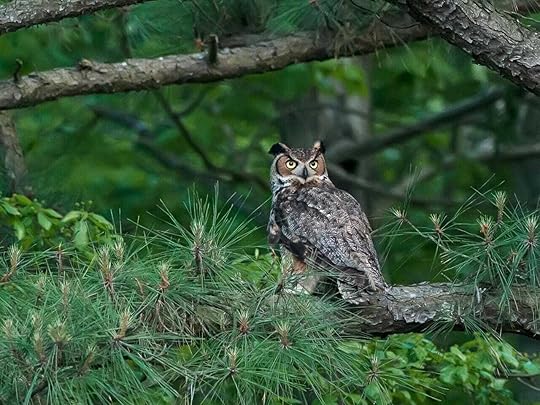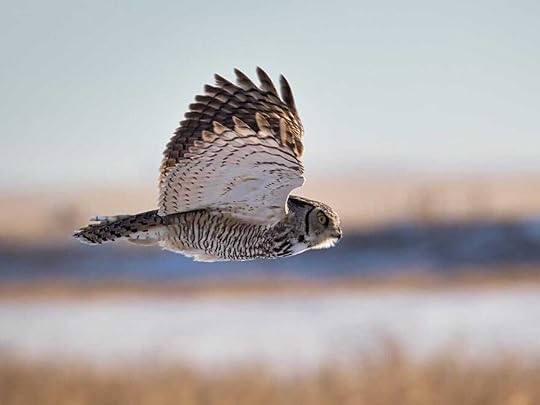We were inside our little house in rural Louisiana. It was after dark. My girlfriend got a text from our next door neighbor saying we had two owls in the trees in our front yard. Our neighbor is a birder like we are.
“Make sure the cat’s indoors,” she added.
After my girlfriend read me the text, I ran outside into the darkness. Right away, I heard them. Them, I say, because the hoots were coming from two different directions. They were deep, resonant hoots. They felt strong enough, profound enough, to travel great distances underwater. They went into your body. The night was crisp, with a trace of fog. I had my flashlight, one of those that casts a runway-illuminating-like beam. I pointed it upward into the trees around our house, but I couldn’t locate the owls.
Hearing this bird’s call is like hearing any wild animal’s call, or roar, or hiss, or screech, or bellow, or whatever sound they make. It creates awe. It brings wild into your heart. It also diminishes your ego. Pushes it aside for something you aren’t and never can be. The owl can do what it does better than you could ever imagine doing it. In fact, it can do what it does better than you do what you do. First of all, it doesn’t think. It reacts. Its mind doesn’t put up barriers between itself and its purpose. Like we do.
What is it, about owls? They are birds, but, somehow, they transcend that category.
Once again, I heard a three-beat—or was it four-beat?—series of hoots. Very distinct. Despite pointing my searchlight into the trees where I thought the calls were coming from, I still couldn’t see either owl. It was tantalizing and frustrating, as birding often is.
Pause. What kind of owl was I hearing? I listened to the various owl calls on my Audubon app, and, as I suspected, they were Great Horned Owls I was hearing. I checked the range just to make sure. The Great Horned is everywhere, from Alaska to Brazil. I’d never seen one, though. Maybe tonight.
Here’s what Cornell U.—they have a terrific birding site on the web—says about the Great Horned Owl: “With its long, earlike tufts, intimidating yellow-eyed stare, and deep hooting voice, the Great Horned Owl is the quintessential owl of storybooks.”

Looks like a Roman emperor posing for a statue. (Photos from Cornell)
Diet? From Audubon.org: “Aggressive and powerful in its hunting, it takes prey as varied as rabbits, hawks, snakes, and even skunks, and will even attack porcupines, often with fatal results for both prey and predator.” What? What a sight that must be, to come upon the two of them caught in a mortal embrace!
Here is a short, slightly melodramatic, but impressive National Geographic video of the Great Horned Owl hunting.
I walked around and around, trying to locate the source of these deep hoots. They were thrilling to hear. I could have followed them for hours. No luck.
But then. Yes, we even have a “but then” here. I heard a deep hoot coming from high up the giant live oak that’s right next to our house. I raised my beam to the branches. Nothing. Then—whoosh!—I saw, right above me, the owl take off and fly easily away, large wings moving the air like a swimmer. The wings were unmistakably white underneath. My flashlight, at last helpful, illuminated the whiteness clearly. Off it went, somewhere.
Are the Great Horned Owl’s wings white underneath?

I went back inside and breathlessly told my girlfriend about this. What’s more exciting than seeing a Great Horned Owl take off from one of our trees, unmistakable, and fly away into the darkness? An ordinary evening was no longer ordinary.
 newest »
newest »
 newest »
newest »
 Great story, Richard. Learned something new. Thank you.
Great story, Richard. Learned something new. Thank you.






